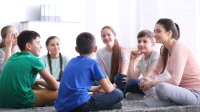Circling Up for Community Building
Restorative practices are used as an alternative to punishment, but these group circles also work to foster a sense of community.
Your content has been saved!
Go to My Saved Content.So you’ve seen the term restorative practices and may even have overheard administrators talking about them. Perhaps your school has proclaimed that it would start to use restorative practices this year. What exactly are restorative practices?
In simple terms, they’re an alternative to the punitive justice that has been used in schools for misbehavior—schools are rapidly adopting restorative practices to replace disciplinary removal. But they can also be used to build a sense of community, because at heart they involve creating a safe space for group discussion.
Regardless of whole school initiatives, teachers can implement their own restorative practices at any time. Simply gather your students in a circle and give them a topic to discuss. The goal is to get students to open up and recognize that they have experiences in common with their classmates. These conversations should be undertaken in small chunks, in specific time set aside to build the classroom community.
Two key components of any restorative practice are that the teacher sets the tone and purpose of the discussion and that the only person who can speak is the one holding a token or talking piece. The talking piece ensures that the other students listen, which helps them learn patience. If someone routinely talks out of turn, they may have to move further back in the queue waiting for a chance to speak. This becomes a social skill lesson in itself, as children can be serial interrupters.
Generally, the teacher starts out with the talking piece in order to set the purpose for the gathering. Then the piece is passed in either direction, and students can speak or not according to their inclination.
Community Circles
The elementary classroom is a perfect setting to practice the skills necessary for a successful restorative practices program. The first step for this undertaking is to establish an environment where students feel comfortable expressing their feelings, and community circles have long been used in lower grade levels to start the day. Kindergarten teachers seem to have a natural proclivity for fostering this type of classroom family. In this situation, the entire class gathers in a rough circle and a topic is presented by the teacher. Community building doesn’t have to wait until a problem arises—it can be a time of offering positive encouragement as well or at the beginning of the year to help build bonds of commonality within the classroom.
This can be done by giving students the chance to express thoughts and feelings in a nonjudgmental way. Begin with questions that any student can answer but that reveal the individual to be a thinking and feeling member of the classroom community. Use prompts like:
- Tell about a time your feelings were hurt.
- What has made you disappointed in the past?
- What does a perfect afternoon look like for you?
- Describe a family member or pet with whom you are very close.
Family Meetings
Proactive teachers use a technique called family meetings to address the myriad issues that arise in a classroom. In these meetings, a particular issue is broached and openly discussed by the entire group. These meetings can take place on a carpeted area or at a group of tables, but maintaining equality among all participants is paramount.
A good teacher already knows where the conversation will go and guides students to arrive at the correct endpoint through the use of guiding questions, just like in a well-prepared lesson. A carefully cultivated classroom environment can even empower students to ask the teacher for a family meeting when they notice undesirable trends occurring.
Restorative Circles
When misbehavior occurs that affects members of the class, a restorative circle is the perfect place to address the concern. This is definitely not a public hearing where the offender is vilified; instead, it’s a forum for students to talk about how the action makes them feel.
For example, let’s say a few students are talking too much and disrupting the class, so the teacher calls a restorative meeting. After the teacher lays out the issue, the entire class is provided opportunity to discuss how the behavior affects their education. Or if a situation occurs where students are picking on one another, the teacher can guide a small-group discussion with the students involved about a time someone has been made to feel worse about themselves due to being ostracized or ridiculed.
At the end of the restorative circle comes the most important piece: Changes are put in place and everyone understands the expectations moving forward. Simply talking about a problem without arriving at a solution is not representative of the restorative process. Changes should be explicit and clearly discussed to avoid any ambiguity; in this way, every student in the circle is aware of what needs to happen in the future.
Everyone has been the victim at one time, and relating the present back to an experience in a student’s past can get them to change their thinking. Likewise, everyone has made another person have negative thoughts about themselves. Restorative practices can help everyone be more mindful in our daily interactions and develop empathy for those occupying our spaces.
Don’t be afraid of using restorative practices in your classroom—just start small, develop a conversation, and let the group share experiences. This is the heart of restorative practices: changing mindsets to be more empathetic and open.
